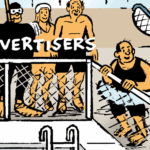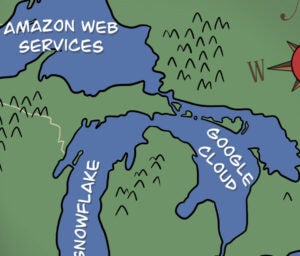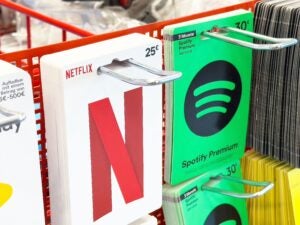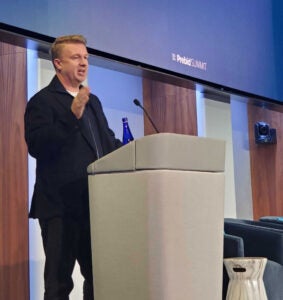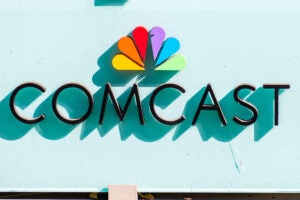“Data-Driven Thinking” is written by members of the media community and contains fresh ideas on the digital revolution in media.
Today’s column is written by Jason Alan Snyder, chief technology officer at Craft Worldwide / McCann Worldgroup.
Those who grew up when MTV first coughed itself awake saw David Byrne “swimming” across their TVs in the iconic Talking Heads music video for the song “Once in a Lifetime.” In it, he warned about the dangers of succumbing to life’s social pressures and pursuing accepted trophies (a large automobile, a beautiful house, a beautiful wife).
“And you may ask yourself, well, how did I get here?”
Those same meditations offered to us by the Talking Heads in the 1980s are similar to what brand marketers ask themselves today:
- How did we get here?
- How do we know what is right and what is wrong?
- How do we know that the success in digital marketing we hold up as a trophy is genuine?
The digital age was supposed to give brands pinpoint accuracy as to their target audiences, but too often the same tools meant to deliver on that promise have led to bewildering concerns about brand safety. More than two-thirds of marketers polled in a 2017 study had to deal with a brand-safety issue at least once.
Today, robotics, artificial intelligence, nanotechnology, quantum computing, biotechnology, the Internet of Things, 3D printing and autonomous vehicles play significant roles in our lives. These technologies are some of the core advancements in what many refer to as the fourth industrial revolution, and they each have great potential to continue to connect billions of people, along with drastically improving the efficiency of business and industry, our educational systems and our health care. They can even help repair our ecology.
While advertising’s role in people’s lives is more important than ever, dealing with brand safety is too often either overlooked or ineffective, as the speed with which a brand’s advertising can appear in an unsafe place usually outpaces the ability to prevent it.
Once in a lifetime
Wrestling with brand safety is a strategy born of the fourth industrial revolution. Technologies that begin with a human imprint, such as artificial intelligence and machine learning, can help ensure that digital advertisements and brand associations do not appear on or in content that conflicts with a brand’s image, mission or goals.
So, perhaps this is a perfect time for us to consider another Talking Heads question – “Am I right, or am I wrong?” – since one of the biggest obstacles facing brands and consumers is the task of discerning what’s real. The challenge in figuring this out comes when our technological interconnectedness and AI-driven utility fails or falls victim to error – whether intentional or not. In a world where billions of us are connected, businesses small and large become vulnerable to a single erroneous placement that spreads virally. It could be a small restaurant becoming falsely associated with food poisoning, a common fake news virus borne by technology that can easily spread, because your favorite AI-powered, natural language processing-enabled GPS app picks up on the post.
Now, imagine the impact of this scenario for a global brand, on a global scale. The results could be more devastating than many realize. Ads repeatedly placed alongside negative content will impact the consumer’s perception of the brand.
Same as it ever was
Of course, brand safety has always been an issue. But most of the brand-safety problems we face now are technological in nature and, unfortunately, most ad-verification solutions rely on technologies that have been surpassed by the publishing technologies they were designed to police. Brands require platforms that discover unsafe online content before brands are exposed to it. Like anything else, the best technology is meaningless without a sound strategy for applying it. Brands need to define what “safe” means to them, understanding what topics prove sensitive to their audiences.
Once the audiences and the brand safety strategies have been determined, it’s time to use sophisticated analysis and machine-learning tools. I have found great success building those solutions with Microsoft’s Azure Machine Learning tool set, since it can be implemented in ways that automate and help improve decision making about customer engagement and lifetime value.
Most crucially, brands need to incorporate a proactive, comprehensive and autonomous brand-safety platform like the excellent platform and systems provided by category innovator CHEQ, which provides scale and proprietary, AI-powered, brand-safety services.
An ounce of prevention is worth a pound of cure.
Even though we have scaled our technological complexity, the goal as both technologists and brand stewards is to go forward by using technology to focus on simplicity and truth. Perhaps it’s helpful not to lose that metered dose of self-reflection Talking Heads offered us:
Time isn’t holding up
Time isn’t after us
Same as it ever was …
Follow McCann (@McCann_WW) and AdExchanger (@adexchanger) on Twitter.



